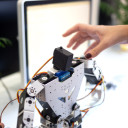
Robotics and AI
20 Mar 2024
Machine learning tools can predict emotion in voices in just over a second
Scientists showed that machine learning tools can identify emotions from audio fragments lasting just 1.5 seconds on par with human ratings

Robotics and AI
20 Mar 2024
Scientists showed that machine learning tools can identify emotions from audio fragments lasting just 1.5 seconds on par with human ratings

Engineering
12 Mar 2024
Scientists use spent brewer’s yeast, left over from manufacturing beer, to filter out metal from waste streams.

Engineering
29 Jan 2024
People who speak the Berlin dialect trust social robots speaking the same dialect more than social robots speaking standard German.

Robotics and AI
22 Dec 2023
Researchers have developed the Dragon Firefighter, a flying firehose that can aid human firefighters to put out the most dangerous fires. Because the design is Open Science, researchers around the world can use these plans to build their own Dragon Firefighters. The authors expect that real-world applications will be possible within a decade.

Engineering
30 Nov 2023
Researchers tested the suitability of a mix of rice husks and cellulose – materials commonly sent to landfills or garbage incineration plants – and found it had good thermal and mechanical properties, making it suitable to be used in a range of applications.

Engineering
03 Nov 2023
by Angharad Brewer Gillham, Frontiers science writer Image/Shutterstock.com Losing your sense of where you are can be fatal enough for aircraft pilots: spatial disorientation is a leading cause of fatal aircraft accidents. But losing your orientation in space itself is even more dangerous. Scientists have now developed wearable devices called vibrotactors that, combined with specialized training, improve people’s ability to fight spatial disorientation and could help astronauts correct themselves when their perceptions can no longer be relied upon. The sky is no longer the limit — but taking flight is dangerous. In leaving the Earth’s surface, we lose many of the cues we need to orient ourselves, and that spatial disorientation can be deadly. Astronauts normally need intensive training to protect against it. But scientists have now found that wearable devices which vibrate to give orientation cues may boost the efficacy of this training significantly, making spaceflight slightly safer. “Long duration spaceflight will cause many physiological and psychological stressors which will make astronauts very susceptible to spatial disorientation,” said Dr Vivekanand P. Vimal of Brandeis University in the United States, lead author of the article in Frontiers in Physiology. “When disoriented, an astronaut will no longer be able to rely […]

Engineering
18 Oct 2023
by Angharad Brewer Gillham, Frontiers science writer Image/Shutterstock.com ‘Social loafing’ is a phenomenon which happens when members of a team start to put less effort in because they know others will cover for them. Scientists investigating whether this happens in teams which combine work by robots and humans found that humans carrying out quality assurance tasks spotted fewer errors when they had been told that robots had already checked a piece, suggesting they relied on the robots and paid less attention to the work. Now that improvements in technology mean that some robots work alongside humans, there is evidence that those humans have learned to see them as team-mates — and teamwork can have negative as well as positive effects on people’s performance. People sometimes relax, letting their colleagues do the work instead. This is called ‘social loafing’, and it’s common where people know their contribution won’t be noticed or they’ve acclimatized to another team member’s high performance. Scientists at the Technical University of Berlin investigated whether humans social loaf when they work with robots. “Teamwork is a mixed blessing,” said Dietlind Helene Cymek, first author of the study in Frontiers in Robotics and AI. “Working together can motivate people […]

Robotics and AI
10 Aug 2023
By Deborah Pirchner, Frontiers science writer Image: Shutterstock.com Malaria is an infectious disease claiming more than half a million lives each year. Because traditional diagnosis takes expertise and the workload is high, an international team of researchers investigated if diagnosis using a new system combining an automatic scanning microscope and AI is feasible in clinical settings. They found that the system identified malaria parasites almost as accurately as experts staffing microscopes used in standard diagnostic procedures. This may help reduce the burden on microscopists and increase the feasible patient load. Each year, more than 200 million people fall sick with malaria and more than half a million of these infections lead to death. The World Health Organization recommends parasite-based diagnosis before starting treatment for the disease caused by Plasmodium parasites. There are various diagnostic methods, including conventional light microscopy, rapid diagnostic tests and PCR. The standard for malaria diagnosis, however, remains manual light microscopy, during which a specialist examines blood films with a microscope to confirm the presence of malaria parasites. Yet, the accuracy of the results depends critically on the skills of the microscopist and can be hampered by fatigue caused by excessive workloads of the professionals doing the […]

Engineering
14 Jul 2023
by Angharad Brewer Gillham, Frontiers science writer Image courtesy of the Hub for Biotechnology in the Built Environment Scientists have developed mycocrete, a paste made with the root network of fungus called mycelium, as a building material. Injecting this into a knitted textile framework creates a composite material which is stronger and more versatile than previous biomaterials made of fungi and could eventually be used to construct lightweight buildings with low environmental impact. Scientists hoping to reduce the environmental impact of the construction industry have developed a way to grow building materials using knitted molds and the root network of fungi. Although researchers have experimented with similar composites before, the shape and growth constraints of the organic material have made it hard to develop diverse applications that fulfil its potential. Using the knitted molds as a flexible framework or ‘formwork’, the scientists created a composite called ‘mycocrete’ which is stronger and more versatile in terms of shape and form, allowing the scientists to grow lightweight and relatively eco-friendly construction materials. “Our ambition is to transform the look, feel and wellbeing of architectural spaces using mycelium in combination with biobased materials such as wool, sawdust and cellulose,” said Dr Jane Scott […]

Robotics and AI
20 Jun 2023
By Deborah Pirchner, Frontiers science writer Image: Shutterstock.com Predicting hit songs is notoriously difficult. Researchers have now applied machine learning (ML) to high-frequency neurophysiologic data to improve hit song prediction accuracy. They showed that if ML was applied to neural data collected while people listened to new music, hit songs could be predicted with close-to-perfect accuracy. This can open doors to providing consumers with the entertainment they are looking for, rather than flooding them with options. Every day, tens of thousands of songs are released. This constant stream of options makes it difficult for streaming services and radio stations to choose which songs to add to playlists. To find the ones that will resonate with a large audience, these services have used human listeners and artificial intelligence. This approach, however, lingering at a 50% accuracy rate, does not reliably predict if songs will become hits. Now, researchers in the US have used a comprehensive machine learning technique applied to brain responses and were able to predict hit songs with 97% accuracy. “By applying machine learning to neurophysiologic data, we could almost perfectly identify hit songs,” said Paul Zak, a professor at Claremont Graduate University and senior author of the study […]

Robotics and AI
08 Jun 2023
by Inês Hipólito/Deborah Pirchner, Frontiers science writer Image: shutterstock.com Inês Hipólito is a highly accomplished researcher, recognized for her work in esteemed journals and contributions as a co-editor. She has received research awards including the prestigious Talent Grant from the University of Amsterdam in 2021. After her PhD, she held positions at the Berlin School of Mind and Brain and Humboldt-Universität zu Berlin. Currently, she is a permanent lecturer of the philosophy of AI at Macquarie University, focusing on cognitive development and the interplay between augmented cognition (AI) and the sociocultural environment. Inês co-leads a consortium project on ‘Exploring and Designing Urban Density. Neurourbanism as a Novel Approach in Global Health,’ funded by the Berlin University Alliance. She also serves as an ethicist of AI at Verses. Beyond her research, she co-founded and serves as vice-president of the International Society for the Philosophy of the Sciences of the Mind. Inês is the host of the thought-provoking podcast ‘The PhilospHER’s Way’ and has actively contributed to the Women in Philosophy Committee and the Committee in Diversity and Inclusivity at the Australasian Association of Philosophy from 2017 to 2020. As part of our Frontier Scientist series, Hipólito caught up with Frontiers to tell us […]

Engineering
22 May 2023
by Angharad Brewer Gillham, Frontiers science writer Image/Shutterstock.com Scientists found that students given a task by a social robot with a voice programmed to be engaging and inspiring performed better and were more creative than students who received the task from an identical robot with a flat voice. Increasingly, social robots are being used for support in educational contexts. But does the sound of a social robot affect how well they perform, especially when dealing with teams of humans? Teamwork is a key factor in human creativity, boosting collaboration and new ideas. Danish scientists set out to understand whether robots using a voice designed to sound charismatic would be more successful as team creativity facilitators. “We had a robot instruct teams of students in a creativity task. The robot either used a confident, passionate — ie charismatic — tone of voice or a normal, matter-of-fact tone of voice,” said Dr Kerstin Fischer of the University of Southern Denmark, corresponding author of the study in Frontiers in Communication. “We found that when the robot spoke in a charismatic speaking style, students’ ideas were more original and more elaborate.” Can a robot be charismatic? We know that social robots acting as facilitators […]

Robotics and AI
10 May 2023
Online Seminar Series Inclusion, accessibility, and social interaction in virtual and augmented reality environments is key to ensure the success of the deployment of this technology at a public scale. Although immersive environments offer fantastic opportunities for creativity, learning, and social interaction, there is a risk of abusive behavior and exclusion of people with special needs. The GuestXR European project embraces artificial intelligence, together with neuroscience and social psychology research to increase harmony and improve the participants’ experience in shared 3D virtual or augmented reality spaces. This seminar series, organized by Frontiers in Virtual Reality journal and partners from the GuestXR project, will start with a webinar on the features of an innovative XR technology for meeting with participants around the world. The series of online series will follow on with sessions on the research and advancements on haptic technologies and 3D audio techniques to support social interactions and inclusion in XR environments. Finally, we will delve into advanced multisensory features to improve accessibility to VR environments by publics with special needs. Speakers Bio: SeminarDate AbstractRegistration linkSEMINAR 1. A Shared XR System with Full Body Avatars and AI Agent Integration for Enhanced Inclusivity17 May 2023, 16.00h CESTIn this webinar, we will discuss an innovative […]

Engineering
18 Apr 2023
by Angharad Brewer Gillham, Frontiers science writer Image/Shutterstock.com Orb weaver spiders make the capture threads of their webs sticky with an aqueous glue made in special aggregate glands. Scientists studied different species living in different environments to see how the glue changed and found that although the glue was mostly made of the same components, the proportions of the proteins involved were different, changing the glue’s properties. Spiders that don’t weave good silk don’t get to eat. The silk spiders produce which creates their webs is key to their survival – but spiders live in many different places which require webs fine-tuned for local success. Scientists studied the glue that makes orb weaver spiders’ webs sticky to understand how its material properties vary in different conditions. “Discovering the sticky protein components of biological glues opens the doors to determining how material properties evolve,” said Dr Nadia Ayoub of Washington and Lee University, co-corresponding author of the study published in Frontiers in Ecology and Evolution. “Spider silk fibers and glues represent a fantastic model for answering such questions since they are primarily made of proteins and proteins are encoded by genes.” “Spider silks and glues have huge biomimetic potential,” added Dr […]

Engineering
04 Apr 2023
By Deborah Pirchner, Frontiers science writer Image: Shutterstock.com Monitoring emissions from volcanoes – particularly sulfur dioxide (SO2) using specialized cameras – is important for hazard forecasting. Gathering long-term time series datasets is critical because volcanoes can exhibit significant changes in activity over time. Now, researchers have developed a cheap and low-power SO2 camera suited for long-term measuring. The tool could have significant implications for millions of people worldwide who live close to active volcanoes, they say. Gas emissions are the manifestation of activity occurring beneath the surface of a volcano. Measuring them lets researchers see what can’t be seen from the surface. This knowledge is vital for hazard monitoring and the prediction of future eruptions. Since the mid-2000s, ultraviolet SO2 cameras have become important tools to measure emissions. The measurement campaigns, however, must be accompanied by a user, making SO2 cameras unsuitable for acquiring long-term datasets. Building and operating this type of camera can cost upwards of $20,000, resulting in very few cameras being installed permanently. To get better long-term monitoring data, an international team of researchers has developed an SO2 camera to continually measure emission rates from volcanoes. They have now published an article about the camera design and two […]